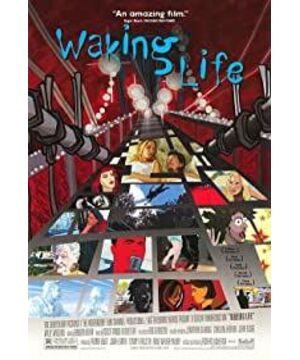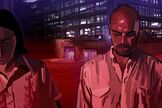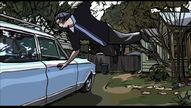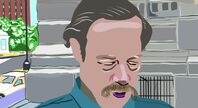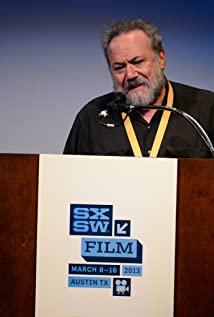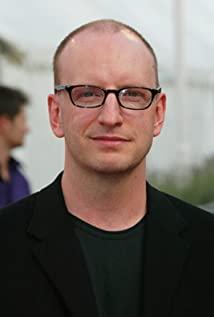1. If I want to study philosophy, I can go to a philosophy book, or go back to the university to study, need he teach me here? The film is not well shot, and the endless lectures are the same as lectures, but the key is not good! Even super-cut cuts like "Mulholland Drive" and "21 Grams" are at least storytelling. What is this movie doing? It's just babble, babble, and if it's like that in front of me, I'll slap him! It's like promoting Amway!
2. I don't like the style of painting either!
3. In view of the fact that some of the views in the film are still reasonable, I did not give one star, not bad, what bike do you want.
=============
This is a thought-provoking film, thinking about the meaning of existence, thinking about the connection between consciousness and existence, and thinking about the relationship between consciousness in dreams and consciousness in waking dreams. Movies that give me goosebumps.
The title of the film is derived from the motto of the Hispanic American philosopher George Santayana: "Sanityisamadnessputtogooduses; wakinglifeisadreamcontrolled." If I had to translate it, I would translate it into "reason is a good product of madness; waking up and life is a controlled dream", if the translation is not good, please forgive me XD.
Director Richard Linklater (Richard Linklater) will use the whole film to live-action and then use animation techniques to present the entire film. The whole film is based on the protagonist's life in dreams and the real world. A series of different scenes appear in the film, such as general streets, schools, bars, restaurants and cinemas.
In these scenes, sometimes the first person is involved in the chat between people, and sometimes the main character and the film's characters (such as: philosophy professor, biology professor, suicide or stranger) are viewed from a third person perspective. etc.) talk. During the conversation, they talked about the meaning of life, the existence of consciousness, free will, the correlation between dreams and reality, and the extension of lucid dreaming to the afterlife, etc.
Sometimes these conversations make me think I'm in it, kind of like a bar chat... lol.
When the protagonist learns about lucid dreaming from the characters he meets in his dreams (ps. By turning on and off the light and the watch LED display XD), it is the climax of the whole movie. The protagonist starts flying and even talks about "feelings of being a character in a dream" with strangers in the dream, etc. However, as the protagonist keeps false awakening in the dream, the protagonist begins to worry about whether he can no longer truly escape from the dream. When I wake up from the dream, I also worry about whether I have died. The whole film gradually extends to the afterlife world, the relationship between the consciousness after death and the dream.
=======
What is the meaning of existence? What is the relationship between consciousness and existence? What about the consciousness in the dream, the consciousness in the wake?
The film was filmed in 2001. The live-action performance was first shot with a camera, then rotoscored with software, and processed into animation later. The opening sentence "dreamisdestiny", which is straightforward and clear, is the independent production of director Richard Linklater, and his reflection on the experience. There are young people in every age who do this kind of thinking.
The story narrates that a young man keeps appearing all kinds of people on his way home, all of them chattering about big truths. From the beginning of Pangu to the theory of evolution, to the golden moment of deconstructing movies, to the anti-establishment complaints, to the two flowers in a parallel world, and even two or three kinds of Romance; from Plato to Aristotle, to Alexander, to Nietzsche, to Saudi Arabia, to Truff, to Robert Louis Swanson and even Dostoyevsky; from university professors to runaway drivers, to men and women in bed, to film directors, to prison bosses to bar Liu Ling, to Yiren on the road and even telephone pole Arbor... ...
Travelling with people, the young man realizes that he can no longer distinguish between dreams and reality. Is it possible to seize reality by breaking free from dreams, or is life just indulging in illusions and constantly rejecting God’s inspiration?
The movie must be chattering, don't give yourself a chance before If I told you that the director made BeforeSunrise (1995) and BeforeSunset (2004), both of which were more drool than tea but deeply attracted you, you might try it.
=========
Some people say that young people of every era have such a representative movie. It seems that if you want to get a glimpse of the youth life in the 1960s, you cannot miss Gundam and Chu Fu; the portrayal of young people in the 1970s is no better than the wild and unruly high school graduates in "Dazed and Confused" (1993). Reverse the external system with actions; in the 1980s, you can see how the young people who were placed on probation in "The Breakfast Club" (The Breakfast Club, 1985) communicated with each other; "The Four Graduates" in the 1990s (RealityBites, 1994) , in the face of the unforeseeable future is mostly doubtful and a little apprehensive; two thousand years later, the young people in "American Pie" (1999) love to play jokes, and their nonsensical behavior always leaves others at a loss.
"Youth and Madness", a teenage film set in 1976, is actually Richard Linklater's 1993 work. The background is the small town of Huntsville, Texas, where Linklater himself spent his teenage years; the story begins on graduation day at the small town high school, how a group of young people are eagerly waiting for the night party to pass the time. It's a graduation day with too long days and too few things to do. They refused to sign the school's anti-tobacco and alcohol honor book, and would rather take to the streets to drive a Chevrolet to start a chasing competition. The cheerleaders took the lead in punishing the beautiful girls who had just entered school. Repair the unpleasant apprentice. Beer is a must in "Youth and Flimsy," so is prom; bored youngsters numb themselves with more boring games when the days are too long; otherwise, this low-budget boring teen movie is surprisingly starry Glitter, with the beautiful Milla Jovovich competently playing the vase, the bearded Matthew McConaughey as the ruffian, and the still-so-young Ben Affleck. Bad boys lead the trouble.
The story of young people is a subject that Linklater has always liked and is good at. Presenting the young people he observes in the spirit of an independent filmmaker, the camera movements in these low-budget films couldn't be simpler and less dramatic. The content of the story can be the boring life of a young man, an overly romantic exotic relationship, or even an inexplicable dream.
But the difference is that Linklater seems rather keen to challenge the film's possible expressions. One of the reflections is that he continued to shoot young people's stories that he was good at in independent production mode, but at the same time, he made more labor-intensive "Linklater-style" animated films.
Beginning with his first feature-length feature film "Slacker" (1991), Linklater challenged the conventional narrative mode of mainstream films. In the 90-minute film, the audience could not find the protagonist or understand the plot; Stop on the same character for too long, and the film often moves forward in the way that A scene hits B scene, changing the camera's point of view. So as events change, the camera shifts to another person. Under the limited film length, everyone under the camera gets such an even amount of time. Just because there is no main story line, everyone can be the protagonist, making "Urban Ronin" like a small Austin movie drawn by the camera. Ukiyo-e of the town.
This bold experiment cemented Linklater's place in the indie world. So there was the later "Youth and Frivolous", and the more popular "Before Sunrise" (BeforeSunrise, 1995). What these films have in common is that Linklater is highly conscious in his handling of "cinematic time" and "real time" (Note 1). Just like the short and hurried film "Youth and Madness" (graduation day), the film in "Love Before Dawn" with a similar length is not too long. Celine and Jesse, who met unexpectedly on the train, decided to stay in Vienna. After spending today together, we will return to our original life track tomorrow. But they lived an unexpectedly long day on the train. Jesse said he saw his dead grandmother on the train. Celine said by the cemetery that she believed in rebirth. They walked past the amusement park bar and bought a poem by the river. Although the movie time is only one day, they live leisurely, as if youth can never be too much.
In addition to recording his youth with movies, Linklater also writes dreams through animation.
The young man in "Waking Life" (2001), who lives in Linklater's small town as a child, has the same anxiety, as if he has had an experience living in a dream, which makes him unable to distinguish the boundary between reality and dream, thinking that he has woken up In fact, it is still stuck in dream-state.
This animation film that is closest to the director's personal experience and youth anxiety is different from the production method of ordinary clay animation. It is produced by Bob Sabiston and his team and is based on the real activities of the actors. With subtle expressions, flexible body movements, and even some traces of dogma, the images in the screen shake realistically from time to time.
Linklater turned all his thoughts about dreams and dreams into images and projected them in "WakingLife". The insomniac boy even started watching a film discussing Bazin in the empty theater, and the boy smiled knowingly as the interviewees in the film discussed whether the film was a derivation of a dream. In the interview (Note 2), Linklater said, "From the very beginning, people realized that the mode of operation of the movie in the human brain is quite similar to the way that the dream unfolds." This relationship that cannot be clearly defined is precisely Linklater's youth. Anxiety since the movie viewing experience, but in "Waking Life", Linklater uses the film to interpret the dream, and also uses the dream to deconstruct the film.
Such a high degree of self-consciousness makes the boy in the film live like a typical literary youth. No matter how brittle his dreams were, they always left him with a lot of anxiety and shock. He kept thinking about the conversations of the people around him, from the incident that he couldn't tell whether it was a dream or a real boat, to the accidental encounter in the bar later, the conversation that confused him also went from Bazin, Kierkegaard to Philip K.Dick 's novel. Was he dreaming of another possible conversation in just one dream?
Although Linklater's recent work "School of Rock" (School of Rock, 2003) is slowly creeping into the mainstream market, the reflection on image time and real time in his early works is later "Love at Sunset in Paris" (Before Sunset, 2004). ) makes a perfect combination.
The reunion after a nine-year absence is not only the romantic situation of Celine and Jesse in the movie, but also Julie Delpy and Ethan Hawke in real life working together again after nine years. In the more than 70 minutes of film time and real time, they eagerly told the story of these nine years to the audience.
Although at first glance in recent years, the young people under Linklater's lens seem to be no longer young, but Linklater still uses the camera to record youth, the past tense; so the nine-year-old in "Love at Sunset in Paris" The flow of youth must be quickly "spoken" in order to catch up with the gap between real time and movie time. As for Linklater's use of immersive animation to think about the nature of movies, and taking the opportunity to combine the dialectics between movies and dreams, such a high degree of self-consciousness in the creation of movies has always been Linklater's way ahead of other directors of the same generation.
View more about Waking Life reviews


